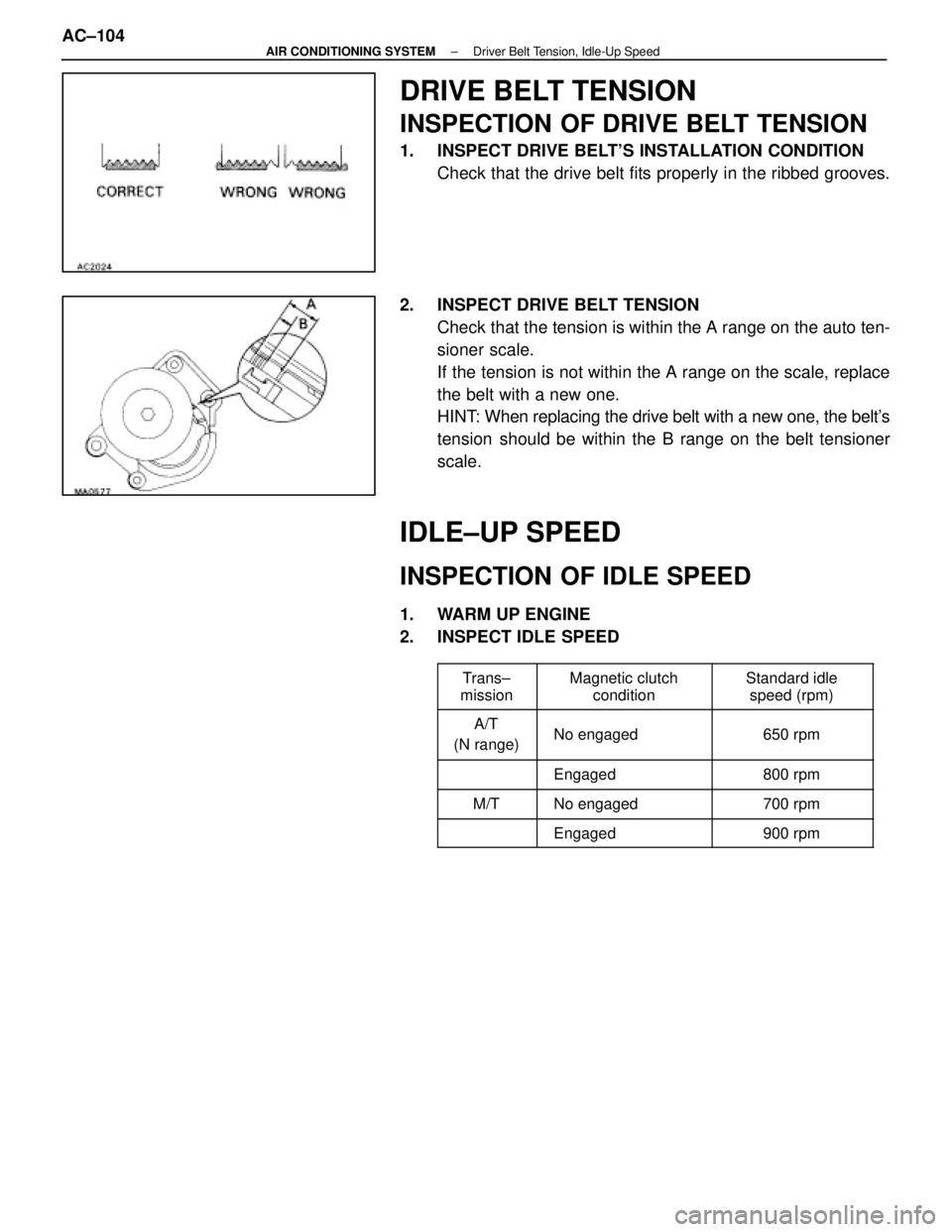Page 140 of 4087

REFRIGERANT VOLUME
INSPECTION OF REFRIGERANT
VOLUME
1. RUN ENGINE AT IDLE SPEED
2. OPERATE A/C AT MAXIMUM COOLING FOR A FEWMINUTES
3. INSPECT AMOUNT OF REFRIGERANT Observe the sight glass on the liquid tube.
ItemSymptomAmount of refrigerantRemedy
1
Bubbles present in sight glassInsufficient*(1) Check for gas leakage with
gas leak tester and repair
if necessary
(2) Add refrigerant until bubbles disappear
2No bubbles present in sight
glassNone, sufficient or too muchRefer to items 3 and 4
3
No temperature difference
between compressor inlet and
outletEmpty or nearly empty(1) Check for gas leakage withgas leak tester and repair
if necessary
(2) Add refrigerant until bubbles disappear
4
Temperature between
compressor inlet and outlet is
noticeably differentProper or too muchRefer to items 5 and 6
5
Immediately after air conditioner
is turned off, refrigerant in sight
glass stays clearToo much(1) Recover refrigerant
(2) Evacuate air and charge
proper amount of
purified refrigerant
6
When air conditioner is turned
off, refrigerant foams and then
stay clearProper
±
*: Bubbles in the sight glass with ambient temperatures higher can be cons\
idered normal if cooling is sufficient.
REFRIGERANT CHARGE VOLUME
Specified amount: 950 + 50 g (33.44 + 1.76 oz)
±
AIR CONDITIONING SYSTEM Refrigerant VolumeAC±103
WhereEverybodyKnowsYourName
Page 141 of 4087

DRIVE BELT TENSION
INSPECTION OF DRIVE BELT TENSION
1. INSPECT DRIVE BELT'S INSTALLATION CONDITIONCheck that the drive belt fits properly in the ribbed grooves.
2. INSPECT DRIVE BELT TENSION Check that the tension is within the A range on the auto ten-
sioner scale.
If the tension is not within the A range on the scale, replace
the belt with a new one.
HINT: When replacing the drive belt with a new one, the belt's
tension should be within the B range on the belt tensioner
scale.
IDLE±UP SPEED
INSPECTION OF IDLE SPEED
1. WARM UP ENGINE
2. INSPECT IDLE SPEED
����� �
����
�����Trans±
mission�������� �
�������
��������Magnetic clutch
condition�������� �
�������
��������Standard idle
speed (rpm)
����� �
����
�����A/T
(N range)�������� �
�������
��������No engaged
�������� �
�������
��������650 rpm
����� �
����
�����
�������� �
�������
��������Engaged�������� �
�������
��������800 rpm
����� �����M/T�������� ��������No engaged�������� ��������700 rpm
����� ������������� ��������Engaged�������� ��������900 rpm
AC±104±
AIR CONDITIONING SYSTEM Driver Belt Tension, Idle-Up Speed
WhereEverybodyKnowsYourName
Page 146 of 4087
9. INSTALL EVAPORATORSee page AC±124
10. INSTALL INSTRUMENT PANEL REINFORCEMENT
11. INSTALL ENGINE See page EM±167
12. E V ACUATE AIR IN REFRIGERATION SYSTEM AND
CHARGE WITH REFRIGERANT
See page AC±17
Specified amount: 950 + 50 g (33.44 + 1.76 oz)
13. INSPECT FOR LEAKAGE OF REFRIGERANT
Using a gas leak tester, check for leakage of refrigerant.
±
AIR CONDITIONING SYSTEM TroubleshootingAC±109
WhereEverybodyKnowsYourName
Page 147 of 4087
COMPRESSOR
INSPECTION OF COMPRESSOR
(Magnetic Clutch)
See page AC±86
(Compressor)
1. INSTALL MANIFOLD GAUGE SET
See page AC±15
2. START ENGINE
3. INSPECT COMPRESSOR FOR METALLIC SOUND Check that there is metallic sound from the compressor when
the A/C switch is turned on.
If a metallic sound is heard, replace the compressor assem-
bly.
4. INSPECT PRESSURE OF REFRIGERATION SYSTEM See ºInspection of Refrigeration System with Manifold
Gauge Setº on page.
5. STOP ENGINE
6. INSPECT VISUALLY FOR LEAKAGE OF REFRIGERANT FROM SAFETY SEAL
If there is any leakage, replace the compressor assembly.
AC±110
±
AIR CONDITIONING SYSTEM Troubleshooting
WhereEverybodyKnowsYourName
Page 163 of 4087
EXPANSION VALVE
ON±VEHICLE INSPECTION
1. CHECK QUANTITY OF GAS DURING REFRIGERATIONCYCLE
2. INSTALL MANIFOLD GAUGE SET
3. RUN ENGINE
Run the engine at 2,000 rpm for at least 5 minutes. Then
check that the high pressure reading is 1,275±1,471 kPa
(13±15 kgf/cm, 185±213 psi).
4. CHECK EXPANSION VALVE If the expansion valve is faulty, the low pressure reading will
drop to 0 kPa (0 kgf/cm, 0 psi), otherwise it is OK.
HINT: When the low pressure drops to 0 kPa (0 kgf/cm, 0 psi),
feel the receiver's IN and OUT sides for no temperature differ-
ence.
REMOVAL OF EXPANSION VALVE
1. REMOVE EVAPORATOR See page AC±124.
2. REMOVE EQUALIZER TUBES
3. REMOVE EXPANSION VALVE
INSTALLATION OF EXPANSION VALVE
1. INSTALL EXPANSION VALVE
Specified torque:
0.31 inch tube 13 N Vm (135 kgf Vcm, 10 ft Vlbf)
0.50 inch tube 22 N Vm (225 kgf Vcm, 16 ft Vlbf)
2. INSTALL EQUALIZER TUBES
3. INSTALL EVAPORATOR
See page AC±124
AC±126
±
AIR CONDITIONING SYSTEM Expansion Valve
WhereEverybodyKnowsYourName
Page 255 of 4087

(1) Turn ignition switch LOCK.
(2) Disconnect center airbag sensor assemblyconnector.
(3) Turn ignition switch ON. But do not start engine.
(4) Measure voltage at IG
2 or ACC on connector
wire harness side of center airbag assembly and
operate electric system (defogger, wiper,
headlight, heater, blower, etc.).
Voltage: 6 V ± 11.5 V at IG
2 and ACC.
(5) Turn electric system switch OFF.
(6) Turn ignition switch LOCK.
(7) Remove voltmeter and connect center airbag sensor assembly.
Does airbag warning light turn off after approx. 10 seconds?
Preparation.
Turn ignition switch ON.
Operate electric system checked in [ 1 ] (4) and
check that airbag warning light goes off after
approx. 10 seconds.
Check diagnostic code, and if a malfunction
code is output, perform troubleshooting
according to malfunction code. If a normal
code is output, replace center airbag
sensor assembly.
Check battery and charging system
(See page CH±1)
INSPECTION PROCEDURE
AB±41SRS AIRBAG ± Troubleshooting
WhereEverybodyKnowsYourName
Page 278 of 4087

DIAGNOSIS SYSTEM
AT09R±07
The electronically controlled transmission system has built±
in self±diagnostic functions. If the malfunction occurs in the
system, the ECM stores the malfunction code in memory and
the O/D OFF (Overdrive OFF) indicator light blinks to inform
the driver. The diagnostic trouble code stored in memory can
be read out by the following procedure.
O/D OFF INDICATOR LIGHT INSPECTION
AT09S±07
1. Turn the ignition switch to ON.
2. Check if the O/D OFF indicator light lights up when the O/D main switch is pushed out to OFF and goes off when
the O/D main switch is pushed in to ON.
HINT:
wIf the O/D OFF indicator light does not light up or stay on
all the time, carry out the check for ªO/D OFF Indicator
Light Circuitº on page AT±112.
w If the O/D OFF indicator light blinks, a trouble code is
stored in the ECM memory.
DIAGNOSTIC TROUBLE CODE CHECK
AT0A3±07
1. Turn the ignition switch ON, but do not start the engine.
2. Push in the O/D main switch to ON.
HINT: Warning and diagnostic trouble codes can be r ead only
when the O/D main switch is ON. If it is OFF, the O/D OFF indi-
cator lights up continuously and will not blink.
3. Using SST, connect terminals TE1 and E1 of the DLC2 or
DLC1.
SST 09843±18020
±
A304E (1UZ±FE) AUTOMATIC TRANSMISSION TROUBLESHOOTINGAT±37
WhereEverybodyKnowsYourName
Page 280 of 4087

CHECK TERMINAL TT OUTPUT
VOLTAGE
AT00R±01
When a voltmeter is connected to the DLC1, the following
items can be checked.
1. Throttle position sensor signal
2. Brake signal
3. Shift position signal
1. VOLTMETER CONNECTION Connect the positive (+) probe of the voltmeter to terminal T
T
and the negative (±) probe to terminal E1 of the DLC2.
HINT: If a voltmeter with small internal resistance is used, the
correct voltage will not be indicated, so use a voltmeter with
an internal resistance of at least 10 k �.
2. TURN IGNITION SWITCH TO ON (DO NOT START THE
ENGINE)
3. CHECK THROTTLE POSITION SENSOR SIGNAL Check if the voltage changes from approximately 0 V to
approximately 8 V when the accelerator pedal is gradually
depressed from the fully closed position.
4. CHECK BRAKE SIGNAL (LOCK±UP CUT SIGNAL)
(a) Open the throttle valve fully to apply approximately 8 V to terminal T
T.
(b) In this condition, check terminal T
T voltage when the brake
pedal is depressed and released.
TT terminal voltage:
0 V (When brake pedal is depressed)
8 V (When brake pedal is released)
5. START ENGINE
6. CHECK SHIFT POSITION SIGNAL (VEHICLE SPEED ABOVE 60 KM/H OR 37 MPH)
Check up±shifting together with terminal T
T voltage.
HINT: Check for light shocks from up±shifting and for
changes in the tachometer.
������������ ������������Gear Position����������� �����������Terminal TT output voltage������������ ������������1st GearBelow 0.5 V������������ �
�����������
������������2nd Gear1.5 ~
2 6 V
������������ ������������3rd Gear3.5 ~ 4.6 V
������������ ������������3rd Lock±up4.5 ~ 5.9 V
������������ ������������O/D5.5 ~ 6.9 V
������������ ������������O/D Lock±up6.5 ~ 7.9 V
If terminal TT output voltage check cannot be performed, per-
form the check of terminal T
T circuit on page AT±120.
±
A304E (1UZ±FE) AUTOMATIC TRANSMISSION TROUBLESHOOTINGAT±39
WhereEverybodyKnowsYourName